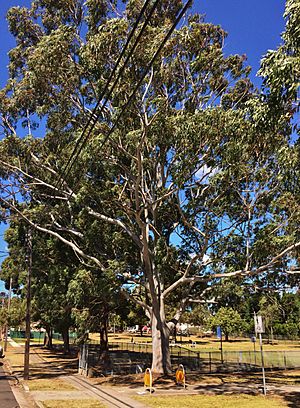Small-fruited grey gum facts for kids
Quick facts for kids Small-fruited grey gum |
|
|---|---|
 |
|
| Grey gum in the Ellenborough River valley | |
| Scientific classification | |
| Genus: |
Eucalyptus
|
| Species: |
propinqua
|

The Small-fruited Grey Gum, also known simply as the Grey Gum, is a type of tree found only in eastern Australia. It's famous for its smooth, patchy bark and its pretty white flowers. This tree is a medium to tall size and is an important part of Australia's forests.
Contents
About the Grey Gum Tree
The Grey Gum tree can grow very tall, sometimes up to 40 meters (about 130 feet) high! It has a special woody swelling at its base called a lignotuber. This helps the tree regrow if it gets damaged, for example, by a bushfire.
Bark and Leaves
The bark of the Grey Gum is smooth and sheds in long strips. It has a cool mottled look with shades of grey, cream, and yellow.
Young trees and new shoots have square-shaped stems. Their leaves are paler underneath, about 4 to 7.5 centimeters (1.5 to 3 inches) long and 1 to 2.2 centimeters (0.4 to 0.9 inches) wide. These leaves have a small stalk, called a petiole.
Adult leaves are also paler green on their underside. They are shaped like a spear or slightly curved. These leaves are longer, usually 6 to 17 centimeters (2.4 to 6.7 inches) long and 1.5 to 2.5 centimeters (0.6 to 1 inch) wide. They also have a petiole, which is about 1 to 2.2 centimeters (0.4 to 0.9 inches) long.
Flowers and Fruit
The Grey Gum's flower buds grow in groups of 7 to 15. They appear where the leaves meet the stem, which is called the leaf axil. Each group of buds is on a short stalk, or peduncle, about 5 to 15 millimeters long. The individual buds are on even smaller stalks, called pedicels, about 1 to 5 millimeters long.
When the buds are ready, they are club-shaped or oval. They are about 3 to 5 millimeters long and 3 millimeters wide. Each bud has a cap, called an operculum, which can be cone-shaped, rounded, or have a small beak.
The Grey Gum flowers from January to April, showing off its white blooms. After flowering, the tree produces woody fruit. These fruits are shaped like a cone or half-sphere. They are small, about 2 to 4 millimeters long and 4 to 6 millimeters wide. Inside, the parts that hold the seeds, called valves, stick out quite a bit.
How It Got Its Name
The scientific name for this tree, Eucalyptus propinqua, was first officially written down in 1896. This was done by two scientists, Joseph Maiden and Henry Deane. They published their description in a scientific paper.
The second part of the name, propinqua, comes from a Latin word meaning "near." This refers to how similar its bark looks to another type of gum tree, E. punctata.
Where the Grey Gum Lives
The Grey Gum grows in open forests. You can find it on low hills and ridges near the coast. Its natural home stretches from Gympie in Queensland down to the Hawkesbury River in New South Wales.
What the Grey Gum Is Used For
The wood from the Grey Gum is very strong and heavy. Because of its strength, it's used for many important things.
- Poles and Piles: It's used for tall poles and for piles that support buildings or structures, especially in water.
- Sleepers: It makes strong railway sleepers.
- Heavy Construction: It's great for big building projects and structures that need to be very tough.
- Marine Construction: Its strength and durability make it useful for things built in or near the ocean.
- Flooring and Decking: It's also used for durable floors and outdoor decks.
Images for kids







